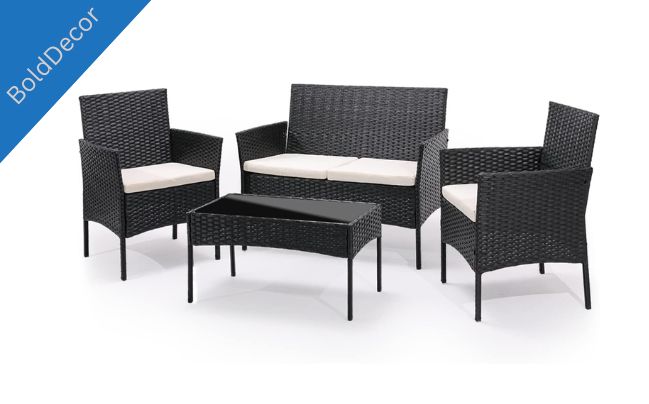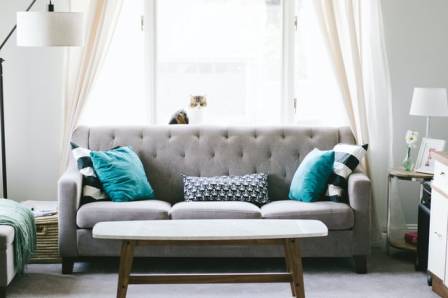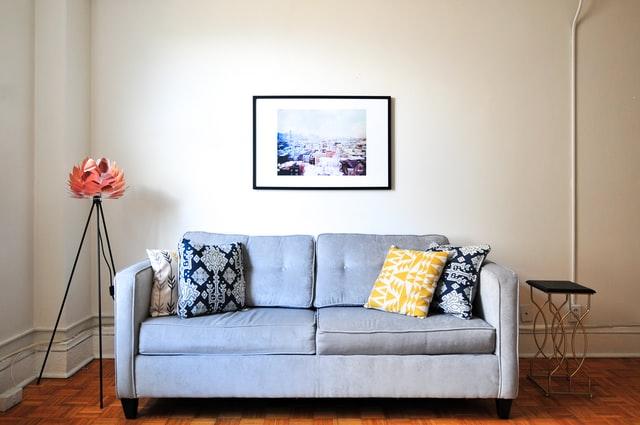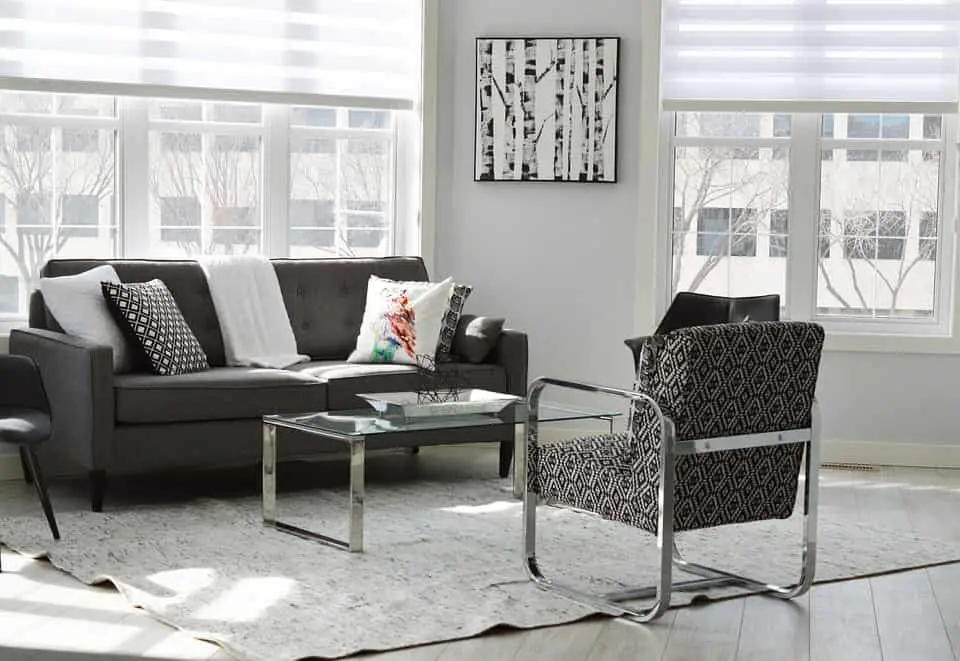Outdoor furniture is the perfect way to transform your patio into a relaxing oasis. However, it is essential to keep your outdoor furniture well-maintained to ensure longevity and durability. Proper maintenance will not only keep your furniture looking new but also prevent costly repairs or replacements.
In this post, we will explore essential tips and techniques for outdoor furniture maintenance. We will discuss cleaning, protecting, and preserving your furniture, as well as DIY repairs and maintenance. Whether you have wooden, metal, or plastic furniture, we have got you covered with expert advice.
Key Takeaways:
- Regular outdoor furniture maintenance prolongs the lifespan of your patio essentials.
- Cleaning your outdoor furniture regularly helps maintain its appearance and functionality.
- Protecting outdoor furniture from the elements, such as sun and rain, is crucial to prevent damage.
- Proper storage of outdoor furniture during the offseason or inclement weather can prevent wear and tear.
- Different types of outdoor furniture require unique maintenance techniques, and it is crucial to understand the materials.
Table of Contents
Understanding the Materials
Before you start with outdoor furniture maintenance techniques, it’s vital to be familiar with the materials that make up your patio furniture. This way, you’ll know exactly how to care for it and ensure that it lasts for years. Here are some common materials you’ll find in outdoor furniture:
Wooden Furniture
Wood is a popular material for outdoor furniture because of its natural beauty and durability. However, it can be susceptible to rot, warping, and decay if not maintained properly. Here are some tips:
- Regularly clean your wooden furniture with a mild soap and water solution.
- Apply a wood protector or sealant to prevent rot and decay.
- Cover your furniture with waterproof covers when not in use to protect from rain and sunlight.
Metal Furniture
Metal furniture is known for its durability but can corrode or rust over time. Here’s how to maintain it:
- Regularly check for rust and corrosion and remove it immediately with sandpaper or rust remover.
- Apply a rust-resistant primer and paint to the affected area.
- Clean your metal furniture with a mixture of mild dish soap and water.
- Apply a coat of car wax to create a protective layer against the elements.
Plastic Furniture
Plastic furniture is lightweight and easy to clean, making it a popular choice for outdoor spaces. However, it can still be prone to discoloration and damage. Here’s how to keep it looking great:
- Clean your plastic furniture regularly with a mixture of vinegar and water.
- Protect it from direct sunlight and heat to prevent melting and fading.
- Invest in UV-resistant covers to protect your furniture when not in use.
Wicker Furniture
Wicker furniture is made from natural or synthetic materials and can be prone to damage from the elements. Here’s how to care for it:
- Clean your wicker furniture with a soft-bristled brush and a mild soap and water solution.
- Use linseed oil or furniture wax to protect it from moisture and sunlight.
- Invest in covers to protect it when not in use.
Tip: Before cleaning or treating any outdoor furniture, always check the manufacturer’s instructions.
Cleaning Outdoor Furniture
Regular cleaning is crucial to keep your outdoor furniture looking its best and functioning correctly. Dirt, debris, and weather elements can take a toll on your furniture, causing damage and wear over time. Follow these outdoor furniture cleaning tips to keep your patio essentials clean and well-maintained:
- Read the Manufacturer’s Instructions: Before cleaning your outdoor furniture, read the manufacturer’s instructions to determine the best cleaning solutions and techniques. Some materials require specific cleaners or tools that may not be compatible with others.
- Remove Loose Debris: Begin by removing any loose debris, such as leaves, dirt, or twigs, from your furniture using a brush or vacuum cleaner. This step makes it easier to clean thoroughly and prevents scratches or damage during cleaning.
- Clean with Water and Mild Soap: For most outdoor furniture materials, mild soap and water are sufficient to remove dirt and stains. Mix a small amount of soap with water in a bucket, then use a soft cloth or sponge to clean your furniture. Rinse thoroughly with clean water and dry with a soft cloth.
- Use Appropriate Cleaners: Some materials, such as metal or wicker, may require specialized cleaners to avoid damage. Check the manufacturer’s instructions or seek professional advice if you’re unsure which cleaner to use.
Tip: Avoid using abrasive cleaners, bleach, or harsh chemicals on your outdoor furniture. These can damage the surface or cause discoloration.
If you have mold or mildew on your furniture, use a solution of water and vinegar or a commercial mold and mildew remover. Apply the solution with a sponge or spray bottle, then let it sit for a few minutes before rinsing thoroughly with clean water. Dry completely with a soft cloth or let it air dry.
Caring for Cushions
Outdoor cushions can add comfort and color to your furniture, but they’re also prone to dirt, stains, and mildew. Follow these tips to keep your outdoor cushions clean and protected:
- Remove Cushion Covers: If possible, remove the cushion covers and wash them separately according to the manufacturer’s instructions. This will help prevent damage to the filling and keep the fabric looking fresh.
- Clean Cushions with Soap and Water: Fill a bucket with warm water and a few drops of mild soap. Dip a soft brush or sponge in the solution and gently scrub the cushions, then rinse thoroughly with clean water and let them dry completely.
- Apply a Fabric Protector: To help repel water and stains, apply a fabric protector spray to your outdoor cushions. This will help prolong their lifespan and keep them looking clean and vibrant.
- Store Cushions Properly: When not in use, store your outdoor cushions in a cool, dry place. Avoid folding or compressing them, as this can damage the filling and fabric. Instead, store them flat or hanging to prevent creases and wrinkles.
Protecting from the Elements
Outdoor furniture is designed to be durable, but it still needs some protection from harsh environmental factors such as rain, sun, and wind. Here are some outdoor furniture maintenance techniques to protect your furniture from the elements.
Invest in Covers
Covers are an effective way to protect your outdoor furniture from rain, snow, and other precipitation. Look for covers that are designed to fit your specific furniture pieces, including tables, chairs, and sofas.
When choosing a cover, look for one made from durable and water-resistant materials like polyester or vinyl. These materials will prevent water from seeping into the furniture and causing damage.
Protect from Sun Damage
The sun’s UV rays can cause outdoor furniture to fade and discolor over time. To prevent this, consider placing your furniture in a shaded area or investing in an outdoor umbrella.
Another way to protect your furniture from the sun is to apply a UV-resistant coating. You can find protective sprays or wipes at most home improvement stores. Be sure to follow the manufacturer’s instructions carefully.
Anchor Furniture
Strong winds can cause outdoor furniture to tip over or blow away, causing damage or injury. To prevent this, anchor your furniture to the ground or to a sturdy structure.
You can use stakes or sandbags to anchor items like umbrellas and lightweight chairs. For heavier items like tables and sofas, consider purchasing furniture anchors or tying them to a fixed structure like a fence or patio post.
Regular Cleaning
Regular cleaning is one of the best ways to protect outdoor furniture from the elements. Dust, dirt, and debris can cause damage over time if left unchecked.
Be sure to clean your furniture regularly, including wiping down surfaces and removing any dirt or debris. Use a mild detergent and warm water, and be sure to rinse the furniture thoroughly after cleaning.
Following these outdoor furniture maintenance techniques can help protect your furniture from the elements and prolong its lifespan. Be sure to check on your furniture regularly to look for signs of damage or wear, and address any issues as soon as possible to prevent further damage.
Preserving Wooden Furniture
Wooden outdoor furniture adds a natural, rustic charm to your patio but requires extra care and attention to maintain its beautiful appearance and longevity. Here are some outdoor furniture maintenance techniques to preserve your wooden pieces:
Regular cleaning
Dirt, dust, and debris can accumulate on wooden furniture over time and cause damage if left unchecked. To clean your wooden patio furniture:
- Use a soft-bristled brush or cloth to remove debris gently.
- Mix equal parts water and white vinegar in a spray bottle, then spritz the solution over the surface of the furniture.
- Wipe the furniture down with a clean, dry cloth, and let it air dry completely.
Protecting from the elements
Exposure to moisture and sunlight can cause wooden furniture to warp, rot, and decay. To keep your wooden furniture in top condition:
- Treat your furniture with a waterproof sealant or varnish to protect against water damage.
- Apply a UV-resistant coating to prevent sun damage and fading.
- Use outdoor furniture covers to shield wooden furniture from rain, snow, and other harsh weather conditions.
Preventing rot and decay
Wooden furniture is susceptible to rot and decay when exposed to moisture. To prevent these issues:
- Raise your furniture off the ground to promote airflow and prevent moisture buildup.
- Apply a fungicide to the furniture to kill any existing mold or mildew.
- Store your wooden furniture in a dry, well-ventilated area during the offseason.
Sanding and refinishing
Sanding and refinishing can help remove any imperfections in the wood’s surface and restore its natural beauty. To refinish wooden furniture:
- Sand the furniture with fine-grit sandpaper to remove any rough spots.
- Clean the furniture with a damp cloth and allow it to dry completely.
- Apply a stain or paint of your choice and allow it to dry completely.
- Seal the furniture with a clear varnish or lacquer.
By following these outdoor furniture maintenance techniques, you can help ensure the longevity of your wooden furniture and keep it looking like new for years to come.
Maintaining Metal Furniture
Metal furniture is known for its durability and resistance to the elements. However, without proper upkeep, it can rust and corrode. Here are some outdoor furniture maintenance techniques to help you care for your metal furniture:
Cleaning
Wipe down your metal furniture regularly with a damp cloth to remove dirt and debris. For tough stains, mix warm water and mild dish soap and scrub gently with a soft brush. Rinse with water and dry thoroughly. Avoid using abrasive cleaners or steel wool, which can scratch and damage the surface.
Protecting
Protect your metal furniture from exposure to moisture and sunlight, which can cause rust and fading. Consider applying a coat of rust-resistant primer and paint to help prevent corrosion. You can also use a metal protector or wax to add an extra layer of protection.
Restoring
If your metal furniture has already started to rust, you can restore it with a little elbow grease. Start by removing any loose rust with sandpaper or a wire brush. Then apply a rust converter to neutralize the remaining rust. Finally, touch up the area with a matching paint or sealant.
| Do: | Don’t: |
|---|---|
| Regularly clean your metal furniture with a damp cloth | Use abrasive cleaners or steel wool |
| Apply rust-resistant primer and paint to prevent corrosion | Expose your metal furniture to moisture and sunlight |
| Use a metal protector or wax to add an extra layer of protection | Store your metal furniture without cleaning and drying it first |
Pro tip: Occasionally lubricate any moving parts, such as hinges or wheels, with a silicone or lithium grease to ensure they work smoothly.
By following these outdoor furniture maintenance techniques, your metal furniture can continue to shine and impress for many years to come. Preventative care and timely repairs are key to extending the lifespan of your outdoor furniture.
Caring for Plastic Furniture
Plastic outdoor furniture is a popular choice due to its affordability, durability, and ease of maintenance. However, it still requires proper care to prevent discoloration and damage over time.
The following outdoor furniture maintenance techniques will help you keep your plastic furniture looking new:
Cleaning
Regular cleaning is essential for keeping your plastic furniture looking fresh. To clean, simply mix a solution of mild soap and water and use a soft cloth or sponge to wipe down the furniture. Avoid using abrasive cleaners or scrub brushes as they can scratch the surface of the plastic. Rinse with a hose and let dry completely before using.
Protecting
While plastic furniture is generally resistant to the elements, prolonged exposure to sunlight and heat can cause it to fade or warp. To protect your furniture, consider using a plastic-friendly spray paint or applying a clear protective coat. Additionally, keeping your furniture covered or in a shaded area when not in use can help prolong its lifespan.
Storing
When storing plastic furniture, make sure it is clean and dry before storing indoors or in a covered area such as a garage or shed. If storing outdoors, use furniture covers specifically designed for plastic furniture to protect it from the elements.
Repairs
If your plastic furniture becomes cracked or broken, it may be possible to repair it with a plastic welding kit or epoxy glue. Follow the manufacturer’s instructions carefully and allow ample time for the adhesive to dry completely before using the furniture.
By following these outdoor furniture maintenance techniques, you can keep your plastic furniture looking new for years to come.
Cushion Care
Outdoor cushions come in various materials like polyester, acrylic, and olefin. They add comfort and style to your furniture and are easy to maintain. To increase the longevity of your cushions, follow these outdoor furniture maintenance techniques.
Cleaning Outdoor Cushions
Regularly cleaning your outdoor cushions can help extend their lifespan. The frequency of cleaning depends on how often you use them and the weather conditions in your area. Here’s how to clean them properly:
- Brush off any loose dirt and debris from the cushions.
- Prepare a cleaning solution of mild detergent and warm water.
- Apply the solution to the surface of the cushions and let it sit for 15-20 minutes.
- Rinse the cushions thoroughly with a hose or bucket of water.
- Let the cushions air dry completely before using them again.
Protecting Outdoor Cushions
Protecting your outdoor cushions from the elements is crucial for maintaining their appearance and functionality. Here are some ways to protect them:
- Invest in protective covers to shield your cushions from rain, sun, and dust.
- Store them indoors during harsh weather conditions.
- Avoid exposing them to strong UV rays as they can cause fading and discoloration.
- Apply a fabric protector to prevent stains and spills from penetrating the material.
Storing Outdoor Cushions
When not in use, store your outdoor cushions in a clean and dry place. Here are some outdoor furniture maintenance techniques for storing your cushions:
- Clean the cushions thoroughly before storing them.
- Ensure they are completely dry to prevent mold and mildew growth.
- Store them in a storage bag or box to protect them from dust and insects.
- Avoid storing them in a damp place or basement as it may cause damage.
Remember to follow the manufacturer’s recommendations for cleaning and maintaining your outdoor cushions.
By following these outdoor furniture maintenance techniques, you can keep your cushions looking and feeling great for years to come.
Storage Solutions
Proper storage is key to maintaining your outdoor furniture’s appearance and durability, especially during the offseason or inclement weather. Follow these outdoor furniture maintenance techniques to ensure your furniture lasts for years to come.
Clean Before Storing
Before storing your furniture, ensure it is clean and dry to prevent mold and mildew growth. Follow the cleaning instructions provided for each material in Section 3. Once clean, let the furniture air dry completely before storing.
Cover or Store Indoors
Covering your furniture with a waterproof cover or storing it indoors can protect it from the elements. If storing indoors, avoid damp areas to prevent moisture from damaging the furniture.
Disassemble if Possible
If your furniture is made up of multiple pieces, disassemble them before storing to save space and prevent damage. Store the pieces in a dry, cool location.
| Type of Furniture | Storage Tips |
|---|---|
| Wooden Furniture | Store indoors or cover with a waterproof cover. Apply a protective coating before storing. |
| Metal Furniture | Store indoors or cover with a waterproof cover. Apply a rust inhibitor before storing. |
| Plastic Furniture | Store indoors or cover with a waterproof cover. Avoid stacking heavy items on top. |
Inspect Regularly
Periodically inspect your stored furniture for any signs of damage or pests. If damage is found, address it immediately to prevent further issues.
Organize with Labels
If storing multiple pieces, use labels to keep track of which parts go together and make reassembly easier. This also helps prevent any missing pieces or confusion when taking the furniture out of storage.
By following these outdoor furniture maintenance techniques for storage, you can preserve the quality and lifespan of your furniture during the offseason or inclement weather.
DIY Repairs and Maintenance
Regular maintenance is essential to ensure the longevity and durability of your outdoor furniture. In this section, we will provide you with some DIY tips and tricks for maintaining your furniture and addressing common issues that may arise.
Scratch and Rust Removal
If you notice scratches or rust on your metal outdoor furniture, you can use sandpaper to remove it. First, clean the affected area with a cloth and mild soap. Then, use sandpaper to gently remove the rust or scratch. Once complete, wipe down the surface with a damp cloth, and dry it off with a towel.
Wooden Furniture Maintenance
Wooden outdoor furniture requires regular maintenance to prevent rot and decay. Apply a sealant or protective coating to the surface of your wooden furniture to maintain its natural color and prevent water damage. You can also use a soft-bristled brush to scrub off any dirt or debris that may be stuck on the surface.
Cushion Repairs
If your outdoor cushions get damaged, you can easily repair them yourself. First, remove the damaged cushion cover and assess the extent of the damage. If the damage is minor, you can sew up the hole or tear using a needle and thread. If the damage is more significant, you may need to replace the cushion filling or cover.
Table and Chair Leg Repairs
If the legs of your outdoor furniture become loose or damaged, you can fix them quickly and easily. You will need a drill, wood glue, and screws to complete this repair. First, disassemble the legs from the table or chair. Then, apply wood glue to the damaged area and reattach the leg to the furniture using screws. Allow the glue to dry completely before using the furniture again.
Cleaning Your Furniture
Cleaning your outdoor furniture regularly is crucial to maintaining its appearance and condition. You can use a mixture of warm water and mild soap to clean most types of outdoor furniture. Be sure to wipe down the furniture with a clean cloth and dry it off thoroughly to prevent water damage.
Conclusion
Following a proper outdoor furniture maintenance guide is crucial in preserving the longevity and durability of your patio essentials. Regular cleaning and protection from environmental factors will go a long way in ensuring your outdoor furniture stays in top shape for years to come. From preserving wooden furniture to caring for plastic furniture, this article has covered various techniques for maintaining different types of outdoor furniture.
Remember, proper storage during the offseason and DIY repairs and maintenance can also help extend the lifespan of your patio furniture. By implementing the tips and strategies shared in this article, you can relax and enjoy your outdoor oasis without worrying about the condition of your furniture.
Thank you for reading and happy outdoor living!
FAQ
How often should I clean my outdoor furniture?
It is recommended to clean your outdoor furniture at least once a month, or more frequently if it gets heavily soiled or exposed to harsh weather conditions.
Can I use regular household cleaners to clean my outdoor furniture?
It is best to use cleaners specifically formulated for outdoor furniture. Regular household cleaners may contain chemicals that could damage the materials or finishes of your outdoor furniture.
How do I protect my outdoor furniture from the sun?
To protect your outdoor furniture from the sun, consider using UV-resistant covers or applying a protective sealant or wax. Also, try to keep your furniture in shaded areas if possible.
How can I prevent mold and mildew on my outdoor cushions?
To prevent mold and mildew, make sure your cushions are dry before storing them, and avoid placing them in damp or humid areas. You can also use a solution of water and vinegar to clean the cushions regularly.
What is the best way to store my outdoor furniture during winter?
When storing your outdoor furniture during winter, it is important to clean and dry it thoroughly. Store the furniture in a dry, covered area or use waterproof covers to protect it from snow and moisture.
How do I fix a broken chair leg on my outdoor furniture?
To fix a broken chair leg, you can use strong adhesive or epoxy glue to reattach it. If the damage is extensive, you may need to replace the entire leg or seek professional help.
How can I restore the shine of my metal outdoor furniture?
To restore the shine of your metal outdoor furniture, clean it thoroughly using a mild detergent and water. Then, apply a metal polish or wax, following the product instructions, to bring back the luster.
Can I use a pressure washer to clean my outdoor furniture?
While a pressure washer can be effective for cleaning some types of outdoor furniture, it can also damage certain materials like wood or wicker. Always check the manufacturer’s recommendations before using a pressure washer.
How can I remove stains from my outdoor cushions?
To remove stains from outdoor cushions, prepare a solution of mild detergent and warm water. Use a soft brush or sponge to gently scrub the stained area, then rinse thoroughly and let the cushion air dry.
What are the signs that my wooden outdoor furniture needs to be resealed?
If your wooden outdoor furniture starts to look dull, shows signs of discoloration, or absorbs water instead of repelling it, it may be time to reseal the wood. Inspect your furniture regularly for any of these signs.





